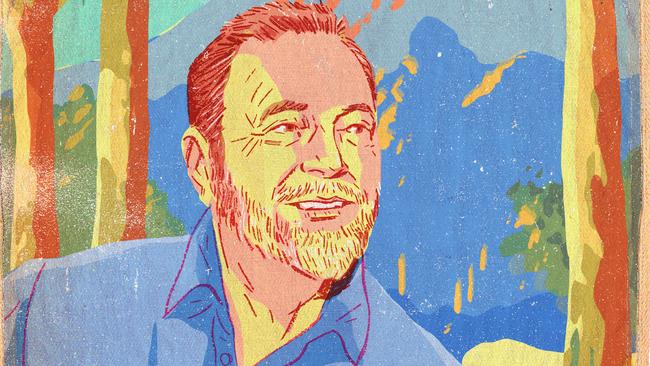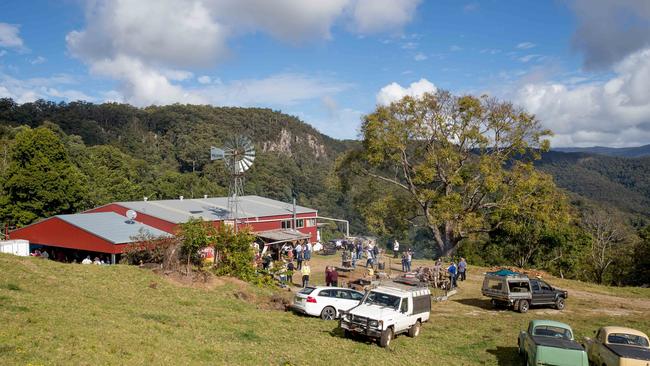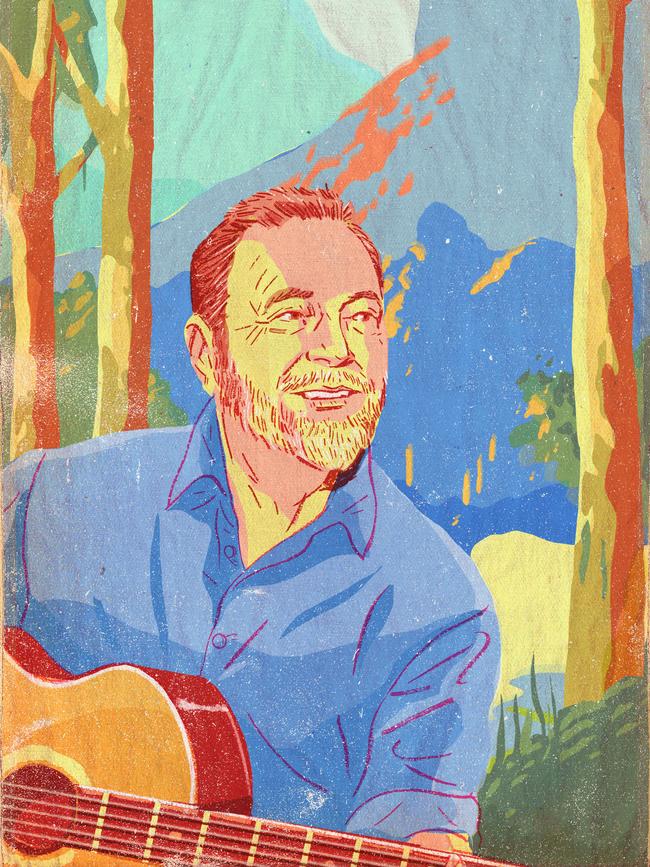Country music icon John Williamson's home among the gum trees
John Williamson is big: but in a changing Australia, why do people still turn to him for songs about the land?

To get to a remote property owned by one of Australia’s greatest songwriters, one must first ascend roads that cut between the innumerable tall trees populating the Gold Coast hinterland. For two days a year, the gate to John Williamson’s place opens, so some of his most ardent fans may park their vehicles in grassy paddocks, then ramble down a muddy track towards a steel structure named Willoshed. It is situated on a sprawling, 69ha block of land the musician has owned since 1976.
Life-size metallic emu artworks stand sentry by the path, watching as fans haul their laden Eskies towards an exclusive experience. From the ridge line looking down, the eye is met with the awesome sight of hectares of pristine, picturesque bushland framed by hills and valleys.
Close by the shed, large rocks encircle a gentle plume of smoke, while a handpainted sign notes: This is a campfire, not a bonfire.

Staff in black aprons attend a shaded stall offering billy tea and snags while, beside the entrance to the building, cups of complimentary champagne are on offer near four portable toilets. It’s a remarkable, well-run production, and spirits are high among the 200 people who have travelled from far and wide to hear songs sung in the country and folk tradition.
If there is one man who has dedicated his life to observing a particular slice of Australian culture and reflecting it back to us, it is Williamson.
Here he is now, the big-selling composer of songs such as True Blue, Rip Rip Woodchip and Raining on the Rock, mingling with his fans on a sunny winter Saturday. He wears glasses, a dark blue shirt and a broadbrimmed hat, and he nurses a cup of tea.

At the fringe of a loose circle surrounding the campfire stand Roger and Connie Wilkinson, who watch as the host casually moves from group to group, shaking hands, posing for photographs and asking his visitors about their travels to be here. Roger has followed Williamson’s career since the mid-1970s, while for Connie — who was born in Canada — the songwriter’s 25th-anniversary compilation, released in 1995, proved an invaluable resource from which she learned a great deal about this nation’s history. “I think he’s probably Australia’s loudest voice, in a gentle way,” she says.
The couple has travelled roughly 1800km from Victoria’s Mornington Peninsula to visit Willoshed for the third year in a row. “We came here all the way for this,” says Roger. “Flew in yesterday afternoon; fly out tomorrow morning. We come here because we like it — and it supports him, too, which he deserves.”
Theirs was not the longest journey: that honour might belong to the happy English couple from Cambridge revelling in the comparatively mild Queensland winter. Other long-distance travellers include a mother and daughter from Geraldton, Western Australia, as well as fans from the likes of Alice Springs, Adelaide, Sydney and Tasmania.
Today gives them an intimate opportunity to spend a few hours in Williamson’s company on his own turf, and soak in the sights, sounds and smells that have inspired him to put pen to paper and fingers to guitar strings.
Though they paid $275 each to be here, they see this as a priceless experience, much more memorable than a sterile entertainment centre meet-and-greet.
Not far from the venue, and secluded just out of sight, is the home the songwriter shares with his wife, Meg, when he’s not performing in the nation’s halls and theatres — or travelling overseas to entertain audiences on a cruise from Fremantle to Gallipoli, as he did as part of the Anzac centenary in 2015, and will do on an upcoming musical safari to South Africa.
At 72, he is much nearer the end of his career than the beginning, yet shows few signs of curtailing his prodigious output. There are whispers of him calling an end to his incessant touring in 2020 to coincide with his 50th year as a recording artist, but until then there are plenty of songs for that unmistakeable voice to sing.
■ ■ ■
Inside Willoshed, rows of white plastic chairs line the cement slab, each facing a raised wooden stage in a far corner. Earlybirds have hung their jackets to indicate possession of prized seats towards the front, while others are happy to set up shop by a wooden bar at the back of the room, including a group of four men in their 30s who have hauled an enormous Esky filled with liquid cheer.
For almost 50 years, Williamson has been known by the title of his breakthrough single — a sign affixed beneath a windmill spinning outside reads Happy 48th birthday, Old Man Emu — and these annual celebrations are neatly timed to coincide with his time in the public eye since that song’s release in June 1970, following an appearance on television talent show New Faces.
As a cultural figure, he is as established and immovable as the red sandstone formation in the centre of the country. By his own reckoning, he has written, recorded and released more than 550 songs during his career, which equates to roughly an album’s worth of material each year, on average.
In that regard, 2018 is no exception: his 52nd album, Butcherbird, is due for release in August. It contains yet more arrangements inspired by this Gold Coast hinterland locale, as well as the Australian country and its people.

The four walls of the shed are covered with a lifetime’s worth of musical souvenirs. The effect is that of a living museum. There’s a lot to take in: a colourful rush of banners, photographs, artwork, flags and signed sporting memorabilia, while in an off-limits corner there’s a typical collection of tools found in any bloke’s shed.
Near a piano is a healthy fire but, on closer inspection, the host notices that someone has deposited a large log on the embers, producing thick smoke. He digs it out with a frown, before asking his staff to open high windows to ventilate the room, lest it affect both patron health and performer’s voice.
By the entrance, the merchandise desk is doing a brisk trade in books, CDs, DVDs, True Blue-branded stubbie coolers and flags. Just after 2pm, a voice is amplified through the speakers. “It’s time to welcome the legend, and creator of Willoshed — please put your hands together for John Williamson.”
From behind a door built into a painted backdrop depicting a scene from Quambatook, the northern Victorian town where he grew up, the songwriter strolls out and takes a seat atop a small platform, acoustic guitar at the ready. On his right side sits bassist Jeff McCormack, while standing at his left is Clare O’Meara, who alternates between violin and accordion.
“Thanks, folks, it’s always an honour that you’ve come all this way,” he begins. “Sorry about that bloody smoke, I dunno, someone put a big log on it. Anyway, folks, I want you to see what inspires me to write songs about this place. I probably write too many because I just think it’s the most wonderful place.
“I’ve been around Australia, as you know, and there’s not many places that the climate’s better than this. I actually like it a little bit cool, so you’ve got an excuse to light a fire — even if it is smoking like mad.”
Williamson wants to show us something. At his command, a door beside the stage is rolled up, presenting a stunning vista of forest, cliffs, hills and sky. As the crowd murmurs its approval, he begins finger-picking a pretty phrase on his guitar. “I was born below the Murray, where the south wind blows colder / Reminds you in the winter that you’re gettin’ on,” he sings. “Where the Mallee holds on to the soil that’s too sandy / It buried my fences, and gave me a song …”
After Hang My Hat in Queensland, he thanks the audience, then says: “Well, with that scene through the door there, you can imagine why I wrote this song, too.” In the chorus of Better Than a Picture, he sings of the variations in colour that we can all see: “And it’s not your summer blue, and it’s not your winter green / It’s more like emerald …”
And so it goes, a collection of readings from a one-of-a-kind songbook that describes worlds both large and small. With nimble fingers, strong voice and a hefty left boot keeping rhythm on his stompbox, he tells us stories of natural splendour; of the futility of young men dying in wars; of disappearing outback towns; of the tough women who support their farmer husbands; and of questioning whether the romance he feels for the Australian bush will survive once he’s gone.
There are few artists whose work has been so widely loved for so long. In addition to winning 26 Golden Guitars and three ARIA awards, Williamson was also inducted into the Roll of Renown and the Hall of Fame at these organisations in 1997 and 2010, respectively.
As well as being acknowledged as a vital performer by his peers, his commercial success is considerable, having sold more than one million albums, according to platinum and gold ARIA accreditations. Whether or not True Blue would make an impact were it written today, rather than in 1981, is hard to say. That song, like much of his best-known works, speaks to an era that might be disappearing in the rear-view mirror. Perhaps Williamson is a man out of time, whose art represents one of the last transmissions between the red dust of country Australia and the urban sprawl where most of us live.
Still, it is quite something to drink so deeply from one man’s cup for two hours, in such a special locale. His facility with language and melody is known to many Australians but in concert his guitar playing is a revelation. Between songs, he moves a capo up and down the neck, and alternates between tricky finger-picked sections, strummed chords and the occasional lead run. His band mates boost the arrangements without ever stepping on the songwriter’s toes.

There is light and shade in these songs. He tells us about the hard job of performing his rendition of Waltzing Matilda at the first anniversary of the Bali bombings in 2003, then at the 10th anniversary. Between those two appearances he wrote Flower on the Water, which was inspired by four lines attached to a photo he saw there on the first visit: “To hear your voice, to see you smile / To sit and talk to you awhile / To be together the same old way / That would be our greatest wish today.”
He dedicates Chandelier of Stars to wife Meg, who later joins him on stage to harmonise beautifully on Call Me Blue.
“All this has been an amazing dream for me,” he says near the end. “It’s become more true than I ever imagined possible. Seeing all your wonderful, friendly faces come here — it’s just unbelievable. I don’t want it to get any bigger. It’s just nice the way it is, hey?”
The final bracket includes four crowd favourites in Raining on the Rock, True Blue, Rip Rip Woodchip and Old Man Emu. Recognising the fans’ standing ovation, he raises his guitar high in the air before heading backstage with his band mates.
An auctioneer takes the microphone to encourage bids for up to six people to spend the night here, to enjoy John and Meg’s home cooking and an intimate campfire performance. Bids start at $2000 and close at $7250, with the proceeds going to Variety NSW, a charity that cares for sick children.
Afterwards, as the attendees begin cleaning up after themselves by stacking the plastic chairs to one side, Roger and Connie Wilkinson approach the merch desk, wallets at the ready, both wearing a look of supreme satisfaction.
“He’s such a treasure, really,” says Connie, beaming. “We should have a day for him, or a stadium, or something national to celebrate what he’s done.”
Williamson was made a Member of the Order of Australia in 1992, “for service to Australian country music and in stimulating awareness of conservation issues”, as his citation notes. Still, Connie may have a point. Perhaps there’s something to that idea of further acknowledgment for his outsized impact on Australian culture; perhaps it might coincide with his intended retirement from touring in two years.
Until then, however, her husband has a succinct way to sum up the singular artistry of the man he’s travelled 1800km to see again. “He makes me proud to be an Australian because of his passion, and his love for this country,” says Roger Wilkinson. “He’s passionate about getting the word out and he does it through song. I love that about him.”
Among the country music fraternity from which he emerged, however, there has been no love lost since Williamson hung up his hat as president of the Country Music Association of Australia — which he co-founded — in 2013.
Never one to shy away from standing up for his beliefs, the songwriter addressed this matter during his performance, too, while introducing a new song whose title name-checks two pioneers of the genre in Slim Dusty and Buddy Williams.
“It was always a battle to keep the American influence out,” he said of his time with the CMAA. “Because as you know — you’re here, you believe in our own music, and our own songs about us, and about our country, sung with an Aussie accent.”
He waited a few beats while the audience applauded, then finished his thought. “I guess sometimes I wonder, when I hear the songs coming through, whether we’ve still got that contact with the bush that the old boys had.”
■ ■ ■
As a chill sets in, the view out the door gradually turns darker shades of purple. Williamson stands at the back bar with a beer, signing merchandise and smiling for photographs with his rapt fans. During the course of an hour the long queue dwindles as the visitors walk back up the muddy track towards their vehicles, with the songs of one man on their mind.
Among the last to leave are the four men in their 30s whose Esky has grown progressively lighter in the preceding hours. By the fireplace in the far corner they stand arm-in-arm, swaying and singing A Number on My Back — “And I will seize the day / ’Cause it belongs to me / I have a number on my back / I am a Wallaby” — just hours ahead of the national rugby team’s test match against Ireland in the Queensland capital.
Before being shepherded out the door, the four men approach Williamson at the signing table. “John, your support for the f..kin’ Diggers — we appreciate that, fair dinkum,” one of them says while shaking the songwriter’s hand in earnest.
As night falls, staff in black aprons set up a few long tables at which the performers, friends and family can relax and debrief over dinner and drinks, before John and Meg welcome another 200 strangers to their property tomorrow. While most of those here today were adults of all ages who have grown up — and grown old — with Williamson’s music, there were a smattering of children in attendance.
Two young boys sat together towards the back of the room, and when the trio on stage launched into Rip Rip Woodchip — Williamson’s 1989 anti-logging anthem, whose opening lines include “Why shouldn’t I get emotional? / The bush is sacred” — the children moved their mouths to every word, and one of them filmed the performance for later viewing.
While the man himself may soon shrink his touring footprint to this stage inside Willoshed, his music will continue to pass between generations, and his timeless songs will long ring out across the valley, over the hills and far away.


To join the conversation, please log in. Don't have an account? Register
Join the conversation, you are commenting as Logout